Journal Club: Evolution of the Hawai’ian honeycreepers
Hawaiian Honeycreeper evolution
SUMMARY: Using a large DNA data set, researchers have identified the progenitor of Hawaiian honeycreepers and have linked their rapid evolution to the geological formation of the four main Hawaiian Islands
.. .. .. .. .. .. .. .. .. .. .. ..
![]() In the middle of the Pacific Ocean, thousands of kilometres away from any significantly-sized landmass, lies the Hawaiian archipelago. Despite its remote location and geological youth, this chain of islands is bursting with an exuberance of life: plants, insects, birds. One group of birds endemic to these islands is the Hawaiian honeycreepers. The “typical” Hawaiian honeycreeper — if there is such a thing — feeds on nectar, has brightly coloured plumage and sings a canary-like song. But each species evolved special feeding habits and a correspondingly special beak shape to fill a different niche found on the specific island within the Hawaiian archipelago. At least 56 species of Hawaiian honeycreepers known to have existed, although (thanks to humans), all but 18 of them are now extinct.
In the middle of the Pacific Ocean, thousands of kilometres away from any significantly-sized landmass, lies the Hawaiian archipelago. Despite its remote location and geological youth, this chain of islands is bursting with an exuberance of life: plants, insects, birds. One group of birds endemic to these islands is the Hawaiian honeycreepers. The “typical” Hawaiian honeycreeper — if there is such a thing — feeds on nectar, has brightly coloured plumage and sings a canary-like song. But each species evolved special feeding habits and a correspondingly special beak shape to fill a different niche found on the specific island within the Hawaiian archipelago. At least 56 species of Hawaiian honeycreepers known to have existed, although (thanks to humans), all but 18 of them are now extinct.
Sadly, like all island-dwelling species, these iconic birds are still going extinct. For example, in 2004, the mysterious snail-eating po’ouli, Melamprosops phaeosoma, became the most recent casualty after the last individual died in captivity. Of the handful of species that still survive, six are considered to be critically endangered by the International Union for Conservation of Nature, four more are endangered and five are vulnerable.
But even this severely diminished array of species is informative: evolutionary biologists and ornithologists consider the Hawaiian honeycreepers to be one of the finest examples of adaptive radiation — even more diverse than Darwin’s famous Galapagos finches.
“There were once more than 55 species of these colorful songbirds, and they are so diverse that historically it wasn’t even entirely clear that they were all part of the same group,” says Heather Lerner, an assistant professor of biology at Earlham College in Indiana and director of the Joseph Moore Museum.
Most authorities agree that one (or maybe more than one) species of cardueline finches (Fringillidae: Carduelinae) are the likely progenitors of the Hawaiian honeycreepers. But whether the honeycreepers evolved from just one parental species or several, and whether there was just one colonisation event or several, is debated. Even though the Hawaiian honeycreepers’ cardueline sister is not known, scientists point to crossbills, Loxia species (doi:10.2307/2406551) and the pine grosbeak, Pinicola enucleator (doi:10.1111/j.1096-3642.2004.00117.x) as good examples of closely related species whose behavioural and ecological traits could act as models for how Hawaii may have been colonised.

The Nihoa finch, Telespiza ultima, dines on birds’ eggs, arthropods, flowers and seeds.
Image: Jack Jeffrey.
.. .. .. .. .. .. .. .. .. .. .. ..
But the tremendous diversity of the Hawaiian honeycreepers, which is readily evident in their wide array of bill shapes and sizes, adds to the confusion.
“Some eat seeds, some eat fruit, some eat snails, some eat nectar. Some have the bills of parrots, others of warblers, while some are finch-like and others have straight, thin bills”, says Dr Lerner. Is it possible that this incredible diversity could have arisen from just one progenitor species in such a short period of time?
An international team of scientists, led by Dr Lerner whilst she was a postdoctoral researcher at the Smithsonian Conservation Biology Institute‘s Center for Conservation and Evolutionary Genetics, set out to answer this question. Her co-advisors, Rob Fleischer and Helen James, have studied the Hawaiian honeycreepers for much of their careers. Together, they conceived of the project, secured all of the funding and were involved in every step of implementing the study.
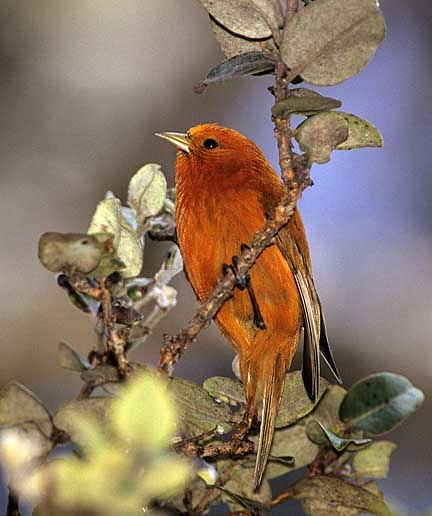
Hawai’i ʻAkepa, Loxops coccineus. This species has a crossed bill that it uses to pry open leafbuds to extract tiny caterpillars.
Image: Jack Jeffrey.
.. .. .. .. .. .. .. .. .. .. .. ..
To identify the potential progenitor of the Hawaiian honeycreepers, Dr James, an expert in identifying Hawaiian bird species by painstakingly examining their subfossils, used her extensive knowledge and skill to identify living bird species whose form and structure were closest to the Hawaiian honeycreepers.
The team assembled a genetic data base of DNA from the bird species chosen by Dr James. The team also added genetically similar birds that shared a geographic proximity to this data base.
“For outgroup species, in addition to selecting species that we had reason to believe might be close relatives of the Hawaiian honeycreepers, we aimed to sample continental regions that surround the Pacific Ocean pretty thoroughly”, says Dr James in email. “We included North American, Eurasian, South American, and some Holarctic species.”
The DNA used in this study was isolated and amplified using cutting-edge next generation DNA sequencing protocols developed by co-authors Michael Hofreiter and Matthias Meyer at the Max Planck Institute for Evolutionary Anthropology in Germany.
The completed genetic data set contained DNA sequences from complete mitochondrial genomes (roughly 17kb) as well as 13 nuclear (chromosomal) loci (8.2kb). These genetic data included all 19 species of recently extant Hawaiian honeycreepers along with 28 closely-related carduelines with the house sparrow, Passer domesticus, as outgroups. This is a large number of close relatives, but it was essential since the true evolutionary history of the Hawaiian honeycreepers was not known. In total, the team amassed more than 22,000 base pairs of sequence data from each of the 47 species.
These sequence data were intensively analysed to identify phylogenetic relationships. Several statistical inference methods, commonly used in science, unambiguously resolved the evolutionary relationships between the honeycreepers and their close relatives, revealing that, amongst the sampled birds, the common rosefinch was the closest relative to the Hawaiian honeycreepers (figure 1, below; or click for larger view):
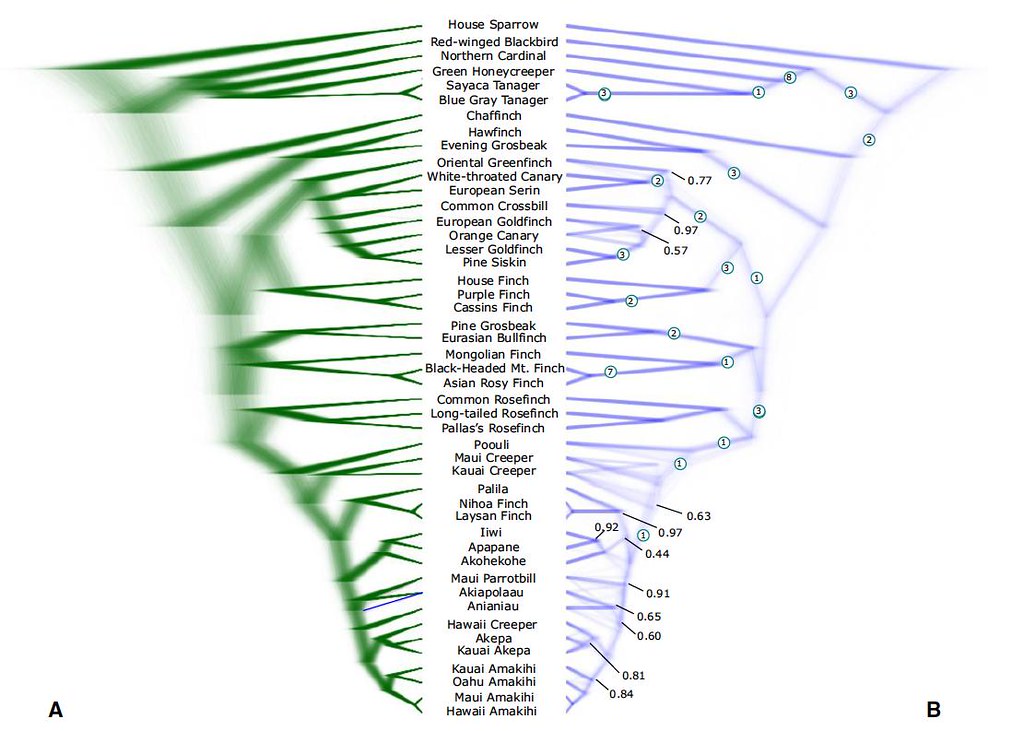
Figure 1.
doi:10.2307/2406551
.. .. .. .. .. .. .. .. .. .. .. ..
When these phylogenetic trees — one constructed from mitochondrial genome data (figure 1A) and the other constructed from both mitochondrial and nuclear data (figure 1B) — are compared to each other, they are remarkably similar.
These data are depicted in two elegant figures; a cloudogram (figure 1A) and a topologram (figure 1B). Both “ograms” are designed to show exactly where the strengths and weaknesses lie in the recovered phylogenetic trees: fuzzier branches reveal more uncertainty in the data analysis whereas darker branches correspond to greater agreement, greater statistical consensus.
“Only two topologies were supported in the Bayesian analysis”, explains Dr Lerner in email.
A cloudogram shows all of the phylogenetic trees recovered by a Bayesian analysis in just one picture — this can be as many as 10,000 trees! In figure 1A, the two topologies match — with the exception of the little blue branch leading to ʻakiapōlāʻau.
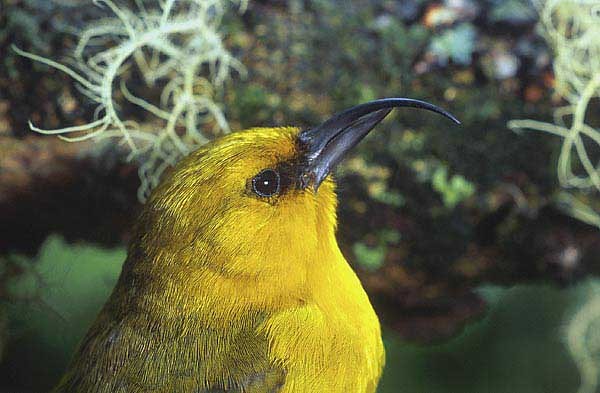
ʻAkiapōlāʻau, Hemignathus munroi, is a passerine version of the woodpecker, feeding on insects hiding within the branches of trees.
Image: Jack Jeffrey [velociraptorise]
.. .. .. .. .. .. .. .. .. .. .. ..
Even though a topologram looks similar to a cloudogram, it differs by not showing every single tree recovered by the statistical analyses. Instead, a topologram sorts all of the recovered trees by their shape and averages the length of each branch. The combination of these averaged-branch-length topologies are then used to generate a single tree and these trees are then compared to each other in the topologram.
“I chose a topologram instead of a consensus tree [for figure 1B], because I wanted to show that the alternative topologies found in this analysis are not vastly different”, explains Dr Lerner in email. “[A]nd [they] mainly differ in whether or not two species are sister or diverge one after the other.”
“[T]his visualization shows that the main uncertainty (which is minimal) lies in the timing of the older branches. This is shown by the fuzziness in the horizontal plane.”
The most surprising finding from this part of the study was that the ancestor of the rosefinches, a group of Eurasian species, is the closest relative to all the extant Hawaiian honeycreepers. Traditionally, many scientists thought that one — or perhaps more than one — finch species was the progenitor for all the Hawaiian honeycreepers, but they did not know what type of finch it was or where it came from. How did the ancestral rosefinch get from the heart of Asia all the way to Hawai’i, the most remote speck of land on the planet — and in sufficient numbers to found an entire group of species?
“One word”, replies Dr Lerner. “Irruption.”
Common rosefinches share an important life history trait with the crossbills and the pine grosbeak: they often move in large mixed-sex groups to new wintering grounds outside their typical range, a behavior known as an ”irruption.” After relocation, they may stay to breed in those new regions.
“Although theoretically it is possible for a very small number of finches to have founded this incredibly diverse radiation in 5-7 million years, I personally find it easier to imagine when I think about the irruptive behavior of rosefinches”, explains Dr Lerner.
“Thousands, even tens of thousands, of these birds will pick up and look for ‘greener pastures’ given even the subtlest of signals of low food supply. One of these irruptive flocks could have gotten carried away in a storm and deposited in the Hawaiian archipelago. Thousands of the birds in that flock could have died during the transport, but still, hundreds or even thousands more could have survived.”
But when did the Hawaiian honeycreepers diverge from their rosefinch ancestors? To answer this, the team looked to the geological history of the Hawaiian archipelago for clues.
“I think that the large distance between islands allows for a high level of isolation among islands which increases the potential for diversification”, says Dr Lerner in email.
The team determined the age of the Hawaiian honeycreeper clade and the tempo of its evolution by applying three island-age calibration points to their time-calibrated mitochondrial-genome phylogeny (figure 2, below; or click for larger view). Based on this analysis, the team estimated that the ancestral rosefinch colonists arrived in the Hawaiian Islands sometime between 7.2 and 5.8 million years ago (mya).
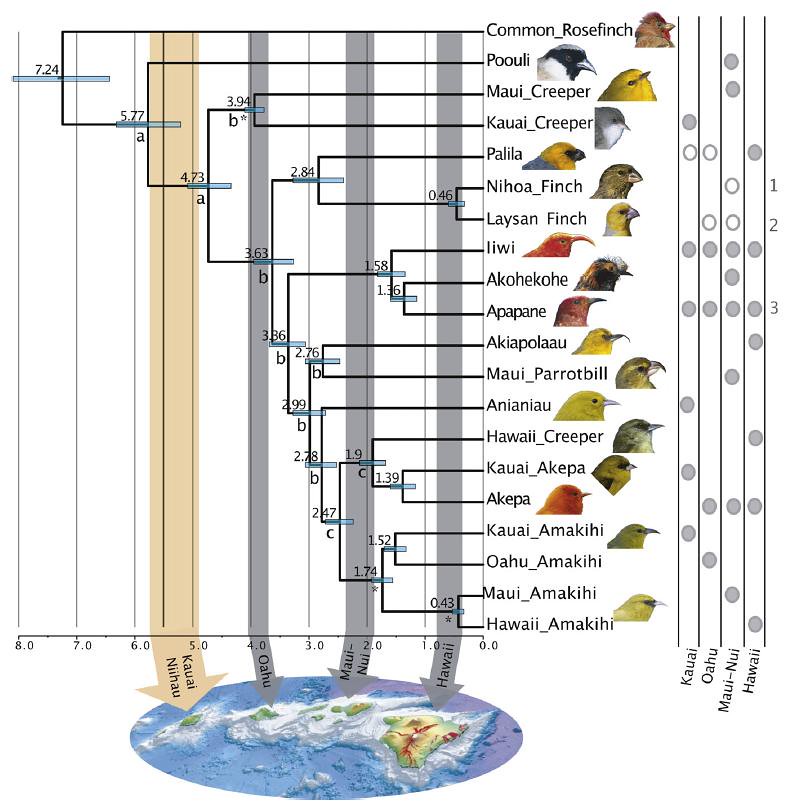
Figure 2.
doi:10.2307/2406551
.. .. .. .. .. .. .. .. .. .. .. ..
These findings suggest that nearly all extant Hawaiian honeycreeper species diverged between 5.8 and 2.4 mya, when the island of Oahu popped up (4.0-3.7 mya). Further, six of the ten major honeycreeper lineages evolved at this time. These findings suggests that, of all the islands in the Hawaiian archipelago, the appearance of Oahu had the biggest impact upon Hawaiian honeycreeper evolution. Its relative isolation from the other islands in the archipelago apparently provided a second major land area that enabled yet more adaptation and speciation for the Hawaiian honeycreepers.
As the avian colonists adapted to the environmental conditions on their home islands, their diet changed. Their bill shapes changed from their finch-y bill to something more suitable to their new lifestyle. Their songs and plumage colouration changed. In short, they speciated. But because these islands are close enough to others within the archipelago, these new species occasionally moved from one island to the next.
“Birds on Kauai diverge from birds on Maui and so on. Birds on Maui can also back-colonize Kauai and the process begins again.”
Island-hopping in the Hawaiian archipelago is a form of time-travel within this small world. These islands are formed by volcanic activity from an undersea magma source. This stationary “hot spot” spews magma whilst the tectonic plate above it moves slowly to the northwest, similar to a conveyor belt moving past a giant assembly line for volcanic islands. The islands at the far northwestern part of the island chain are many millions of years old. At the southeastern end of the chain, new volcanoes are popping up. Currently, a new seamount is rumbling towards the surface of the sea just south of the Big Island, which is only half a million years old — the youngest island in the archipelago.
The combination of this archipelago’s remoteness, its number of reasonably large and topologically complex islands, and its geological youth is what makes Hawai’i an unique “evolutionary laboratory”. Most Hawaiian plants and animals are found nowhere else in the world, and the age of the species mirror the age of the island they live on.
“This radiation is one of the natural scientific treasures that the archipelago offers out in the middle of the Pacific,” said co-author Dr James in a press release.
“It was fascinating to be able to tie a biological system to geological formation and allowed us to become the first to offer a full picture of these birds’ adaptive history.”
Inspired by these findings, Dr Lerner is currently sequencing DNA obtained from museum specimens and subfossils from as many extinct Hawaiian honeycreepers as possible to determine where these extinct species fit into the honeycreeper family tree.
Future studies will examine ancient DNA that is damaged or degraded, so Dr Lerner will once again utilise the latest innovative techniques to build a sufficiently informative data set.
“For me, the mystery of Hawaiian honeycreeper evolution won’t be fully solved until we can confidently place every morphological lineage in the tree, including the lineages represented only by historical and ancient specimens”, she states. “I am working on using DNA sequence capture to be able to obtain enough data to be able to place those other taxa.”
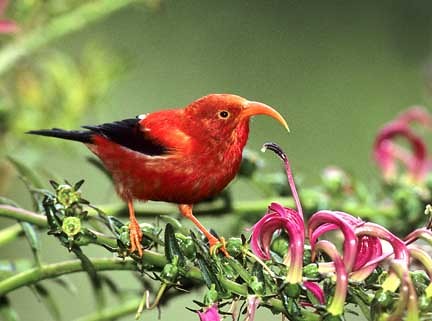
‘I’iwi, Vestiaria coccinea, is a nectarivorous species.
Image: Jack Jeffrey.
.. .. .. .. .. .. .. .. .. .. .. ..
Note: this piece is mirrored from here.
Sources:
Lerner, H., Meyer, M., James, H., Hofreiter, M., & Fleischer, R. (2011). Multilocus Resolution of Phylogeny and Timescale in the Extant Adaptive Radiation of Hawaiian Honeycreepers. Current Biology, 21 doi:10.1016/j.cub.2011.09.039
Heather Lerner [emails; 21, 23, 25 & 27 October 2011]
Helen James, Curator in Charge of birds, Smithsonian Institute [emails; 2 & 3 November 2011]
Trevor Price [email; 1 November 2011]
Smithsonian Institute’s press release
Featured art (above the jump) by H. Douglas Pratt.
Other cited sources:
Bock, W. (1970). Microevolutionary Sequences as a Fundamental Concept in Macroevolutionary Models. Evolution, 24 (4) doi:10.2307/2406551
James, H. (2004). The osteology and phylogeny of the Hawaiian finch radiation (Fringillidae: Drepanidini), including extinct taxa. Zoological Journal of the Linnean Society, 141 (2), 207-255 doi:10.1111/j.1096-3642.2004.00117.x
Read more about endemic Hawai’ian birds:
The Race to Save the World’s Rarest Bird: The Discovery and Death of the Po’ouli by Alvin Powell [2008: Stackpole Books; Amazon UK; Amazon US]. (My review of this book.)
Seeking the Sacred Raven: Politics and Extinction on a Hawaiian Island by Mark Jerome Walters [2006: Island Press; Amazon UK; Amazon US]. (My review of this book.)
.. .. .. .. .. .. .. .. .. .. .. ..
twitter: @GrrlScientist
facebook: grrlscientist
email: grrlscientist@gmail.com
NOTE: minor changes were made to one paragraph discussing the progenitor of the Hawaiian honeycreepers and the rosefinches. These changes clarify the fact that Hawai’i wasn’t colonized by the common rosefinch of today exactly, but rather, it was colonised by a common ancestor of rosefinches and honeycreepers that lived about 5 million years ago. [0920 GMT, 3 November 2011]
